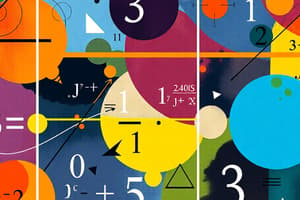Podcast
Questions and Answers
What branch of mathematics primarily deals with the relationships between angles and sides of triangles?
What branch of mathematics primarily deals with the relationships between angles and sides of triangles?
- Algebra
- Geometry
- Trigonometry (correct)
- Calculus
Which of the following operations is considered a basic mathematical operation?
Which of the following operations is considered a basic mathematical operation?
- Multiplication (correct)
- Exponentiation
- Factorization
- Radical calculation
What type of equation always has one output for each input?
What type of equation always has one output for each input?
- Quadratic equation
- Function (correct)
- Linear equation
- Polynomial equation
Which theorem states that in a right triangle, the square of the hypotenuse is equal to the sum of the squares of the other two sides?
Which theorem states that in a right triangle, the square of the hypotenuse is equal to the sum of the squares of the other two sides?
What aspect of mathematics is concerned with data collection, analysis, interpretation, and presentation?
What aspect of mathematics is concerned with data collection, analysis, interpretation, and presentation?
Which of these types of numbers includes both negative and positive whole numbers as well as zero?
Which of these types of numbers includes both negative and positive whole numbers as well as zero?
In which branch of mathematics would you study derivatives and integrals?
In which branch of mathematics would you study derivatives and integrals?
Which mathematical concept measures the likelihood of occurrences of events?
Which mathematical concept measures the likelihood of occurrences of events?
Which of the following best describes linear functions?
Which of the following best describes linear functions?
Which of the following applications of mathematics involves calculating interest and budgeting?
Which of the following applications of mathematics involves calculating interest and budgeting?
Flashcards are hidden until you start studying
Study Notes
Overview of Mathematics
- Mathematics is the study of numbers, quantities, shapes, and patterns.
- It is divided into several branches:
- Arithmetic: Basic operations (addition, subtraction, multiplication, division).
- Algebra: Focuses on symbols and the rules for manipulating those symbols.
- Geometry: Studies the properties and relationships of shapes and spaces.
- Trigonometry: Examines the relationships between angles and sides of triangles.
- Calculus: Explores change and motion, using derivatives and integrals.
- Statistics: Deals with data collection, analysis, interpretation, and presentation.
- Probability: Measures the likelihood of occurrences of events.
Key Concepts
- Numbers:
- Types: Natural numbers, whole numbers, integers, rational numbers, and irrational numbers.
- Equations:
- Expressions that show the equality between two mathematical expressions.
- Common types: Linear equations, quadratic equations, and polynomial equations.
- Functions:
- A relation where each input has a single output.
- Types include linear, quadratic, exponential, and logarithmic functions.
Mathematical Operations
- Basic Operations:
- Addition (+): Combining quantities.
- Subtraction (−): Finding the difference between quantities.
- Multiplication (×): Repeated addition of a number.
- Division (÷): Splitting a quantity into equal parts.
Key Theorems and Principles
- Pythagorean Theorem: In a right triangle, the square of the hypotenuse is equal to the sum of the squares of the other two sides (a² + b² = c²).
- Fundamental Theorem of Algebra: Every polynomial equation of degree n has exactly n roots in the complex number system.
- Law of Sines and Cosines: Relates the angles and sides of triangles in trigonometry.
Applications of Mathematics
- Science and Engineering: Used in modeling and solving real-world problems.
- Finance: Essential for calculating interest, investments, and budgeting.
- Computer Science: Algorithms and data structures often rely on mathematical concepts.
Study and Practice Tips
- Practice regularly to reinforce concepts.
- Solve a variety of problems to understand different applications.
- Use visual aids like graphs and diagrams for better comprehension.
- Review foundational concepts frequently to build upon them.
Overview of Mathematics
- Mathematics studies numbers, quantities, shapes, and patterns, encompassing various branches.
- Arithmetic involves basic operations like addition, subtraction, multiplication, and division.
- Algebra manipulates symbols according to defined rules, working with equations and formulas.
- Geometry investigates shapes and their properties, including angles, lines, and areas.
- Trigonometry analyzes the relationship between angles and sides in triangles, crucial for various applications.
- Calculus focuses on change and motion, utilizing concepts such as derivatives and integrals.
- Statistics centers on data management, including collection, analysis, and interpretation.
- Probability assesses the likelihood of events, providing a mathematical framework for predictions.
Key Concepts
- Numbers are categorized as:
- Natural (positive integers), whole (natural numbers plus zero), integers (positive and negative whole numbers), rational (fractions), and irrational numbers (non-repeating decimals).
- Equations represent equality between expressions, with common types being linear, quadratic, and polynomial equations.
- Functions define relations where each input corresponds to a single output; common types include linear, quadratic, exponential, and logarithmic.
Mathematical Operations
- Basic Operations include:
- Addition (+): Combining quantities to find a total.
- Subtraction (−): Determining the difference between quantities.
- Multiplication (×): Repeatedly adding a number to itself.
- Division (÷): Distributing a quantity into equal segments.
Key Theorems and Principles
- Pythagorean Theorem dictates in right triangles that the square of the hypotenuse equals the sum of squares of the other two sides (a² + b² = c²).
- Fundamental Theorem of Algebra asserts that a polynomial equation of degree n has n roots in the complex number system.
- Law of Sines and Cosines connects angles and sides in triangles, essential for trigonometric calculations.
Applications of Mathematics
- Science and Engineering utilize mathematics for modeling and addressing real-world challenges and phenomena.
- In Finance, mathematics is critical for computing interest rates, managing investments, and budgeting effectively.
- Computer Science applies mathematical concepts to develop algorithms, data structures, and optimize processes.
Study and Practice Tips
- Regular practice helps reinforce mathematical concepts and improves retention.
- Engage with a variety of problem types to grasp different applications and scenarios.
- Use visual aids, such as graphs and diagrams, to enhance understanding and clarify complex ideas.
- Frequent review of foundational concepts ensures a solid base for advanced topics and applications.
Studying That Suits You
Use AI to generate personalized quizzes and flashcards to suit your learning preferences.




